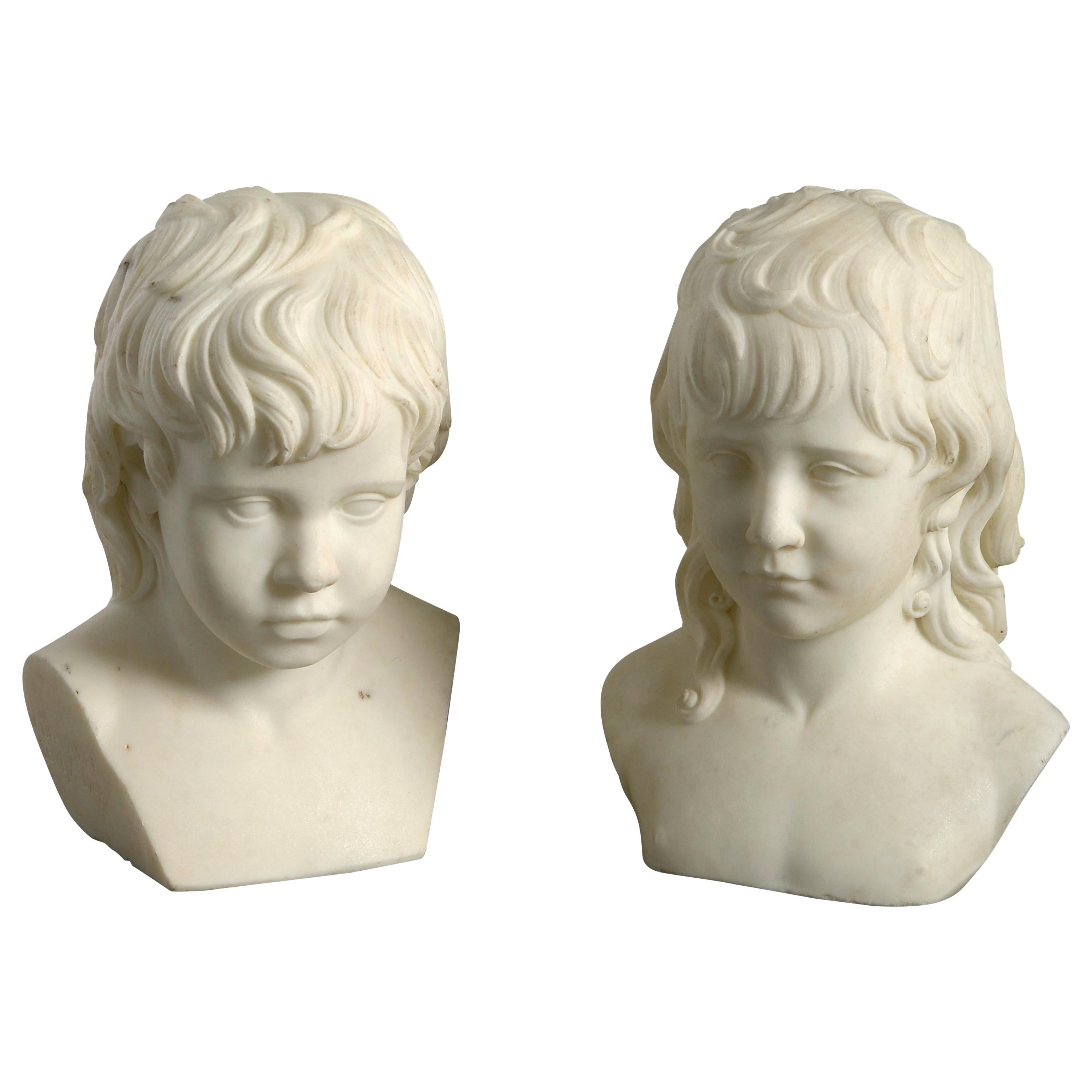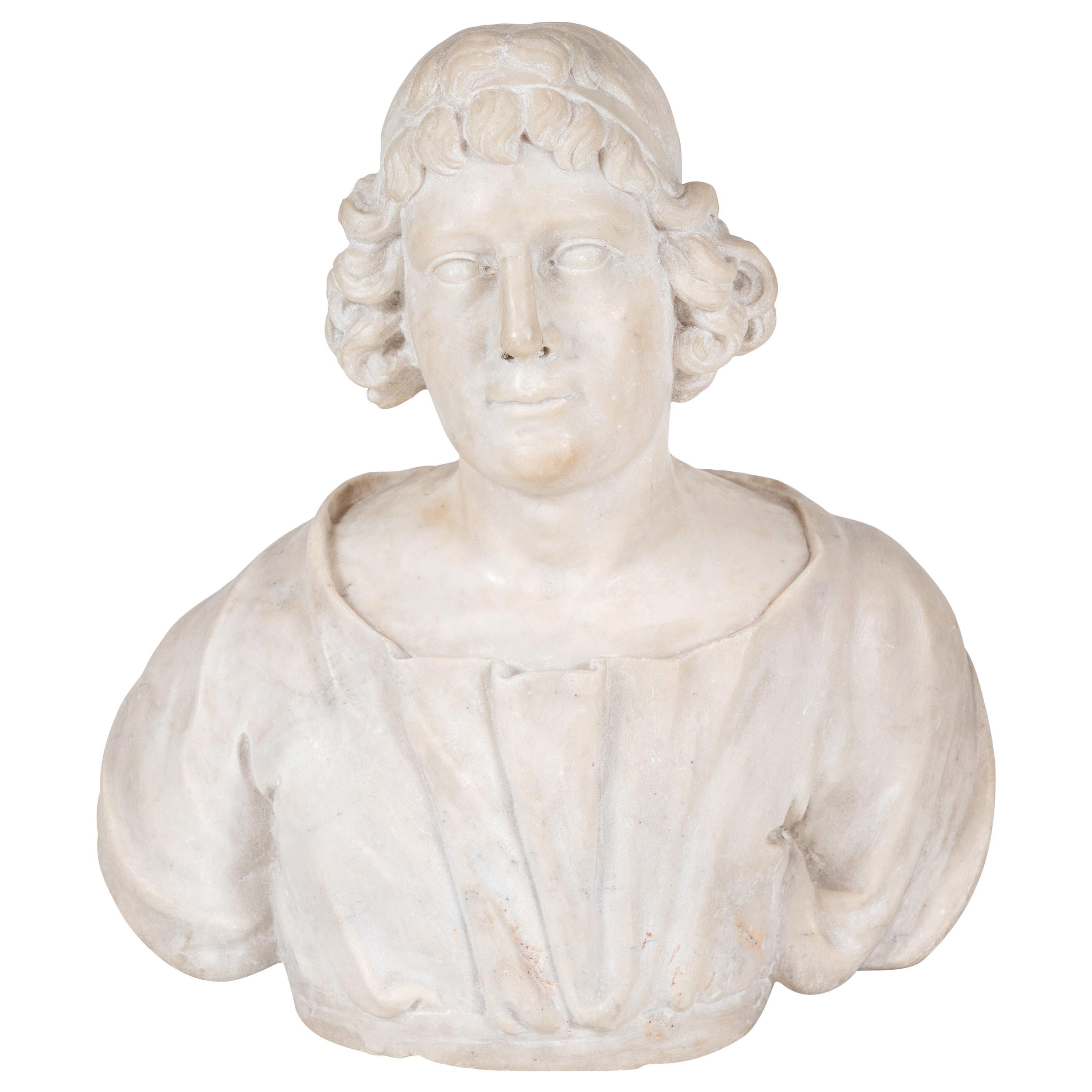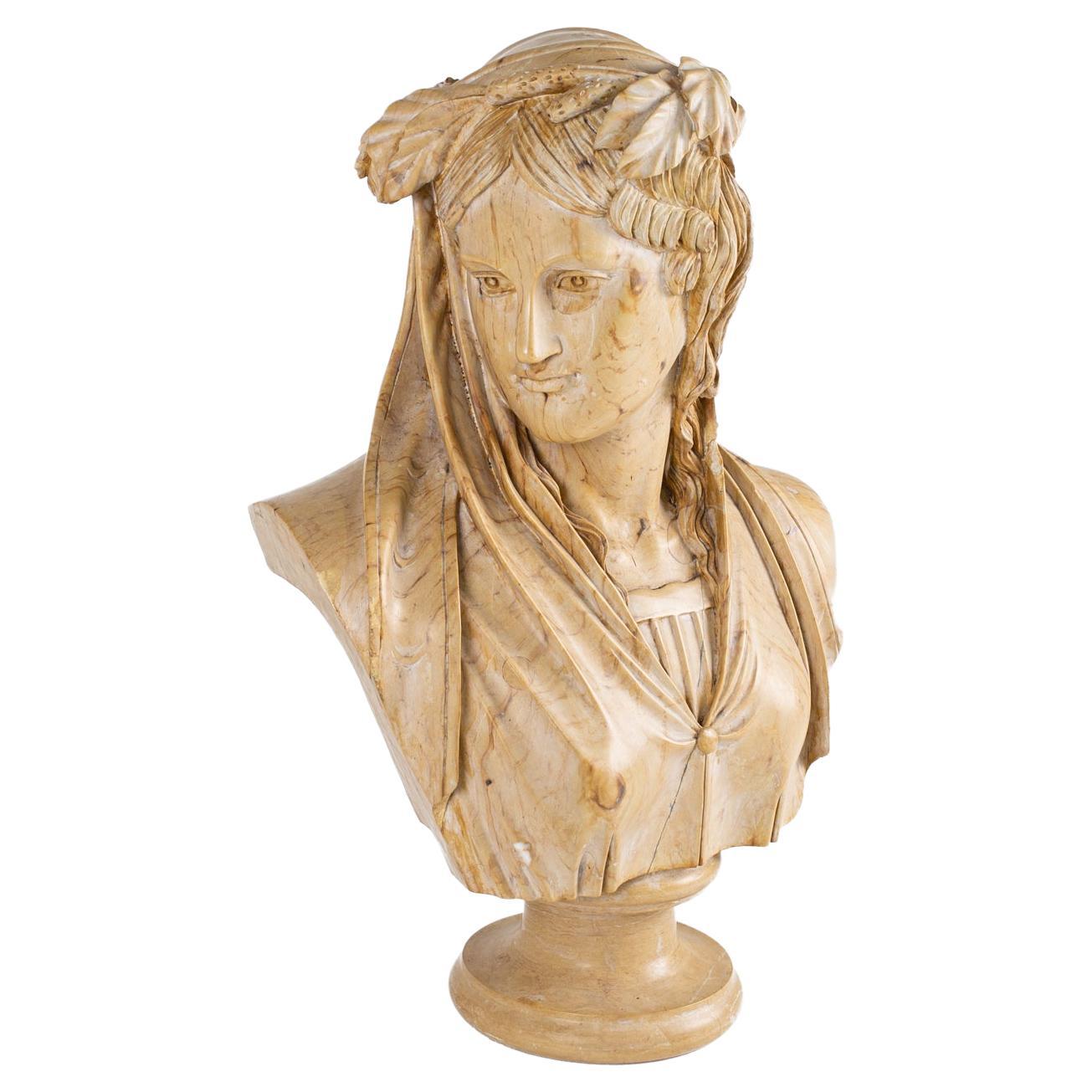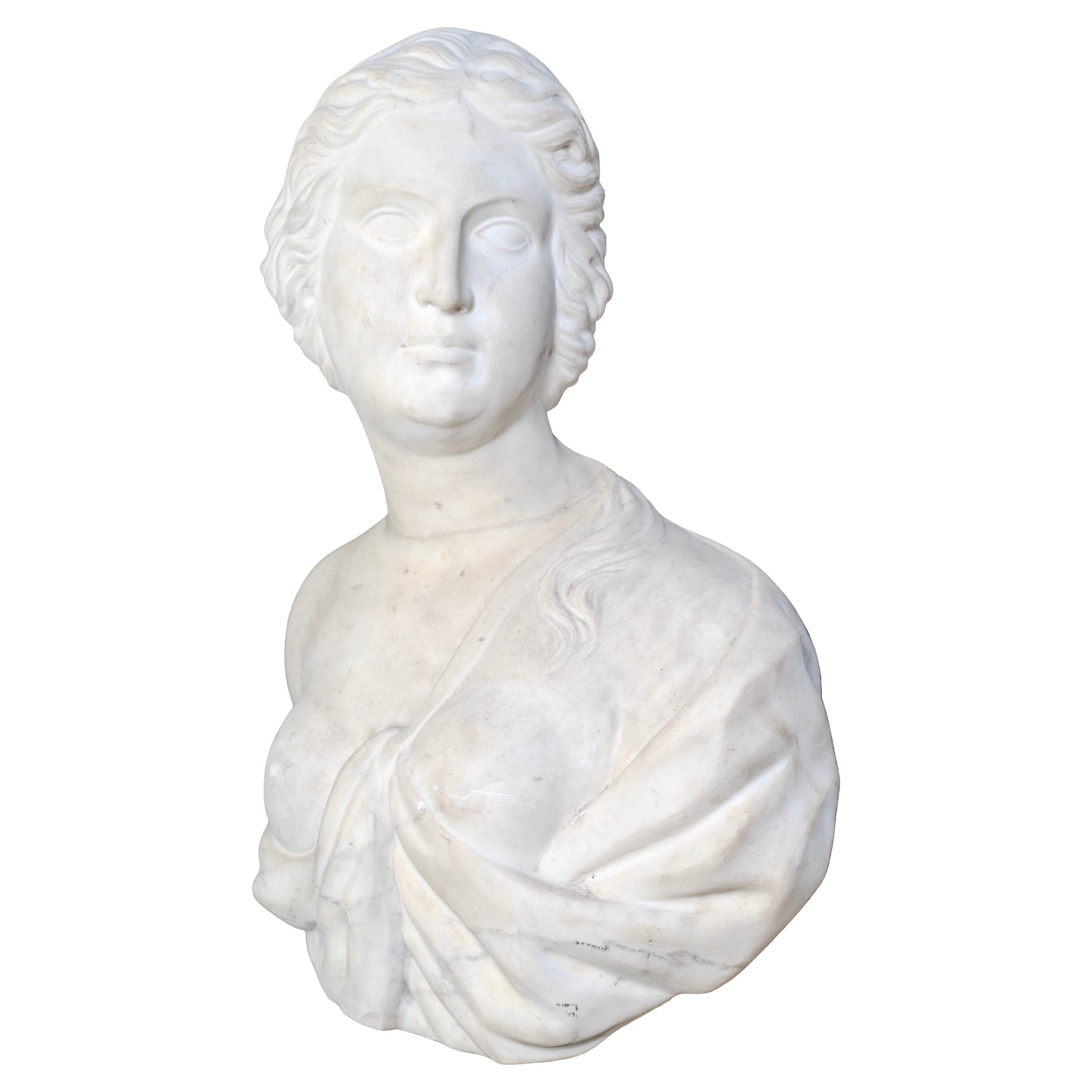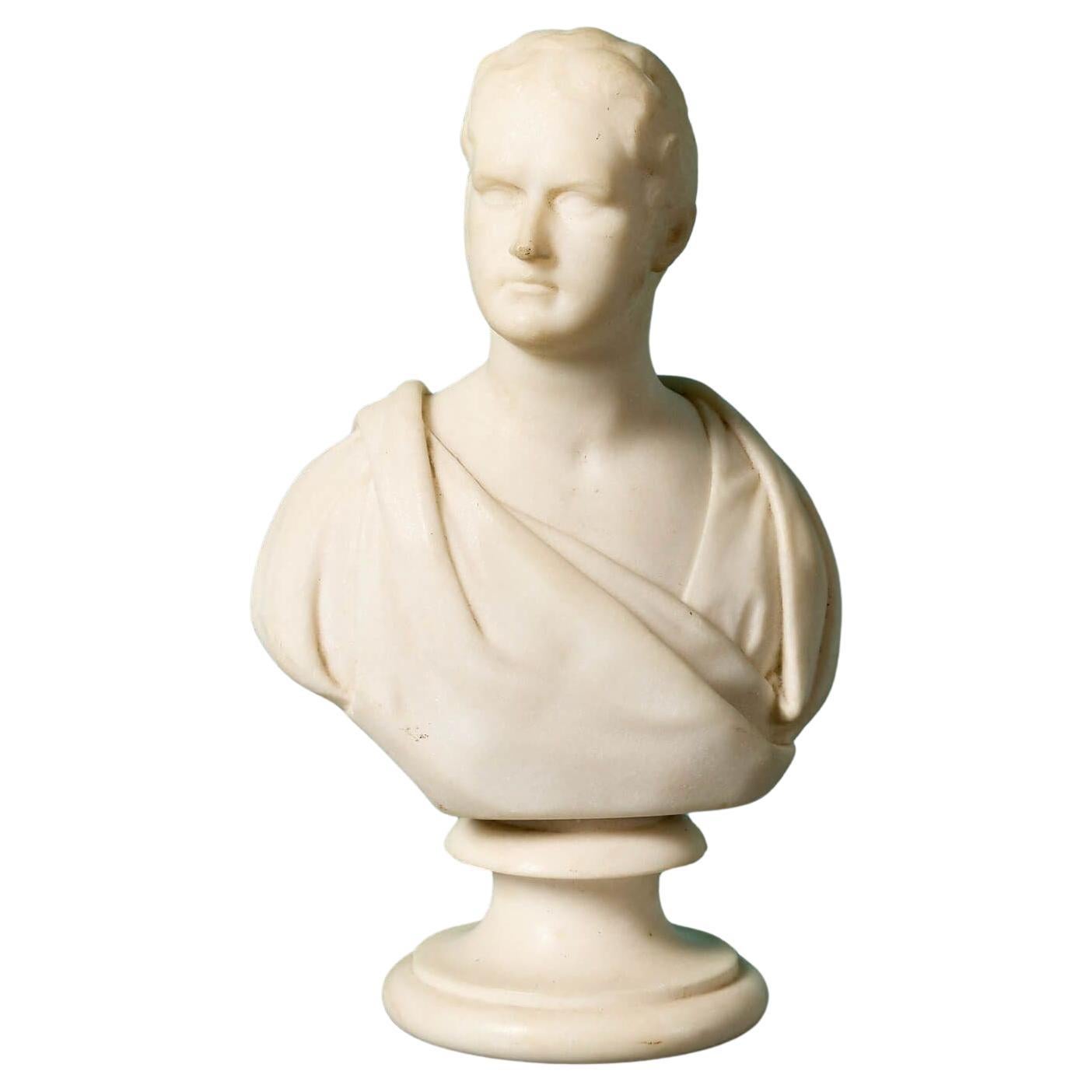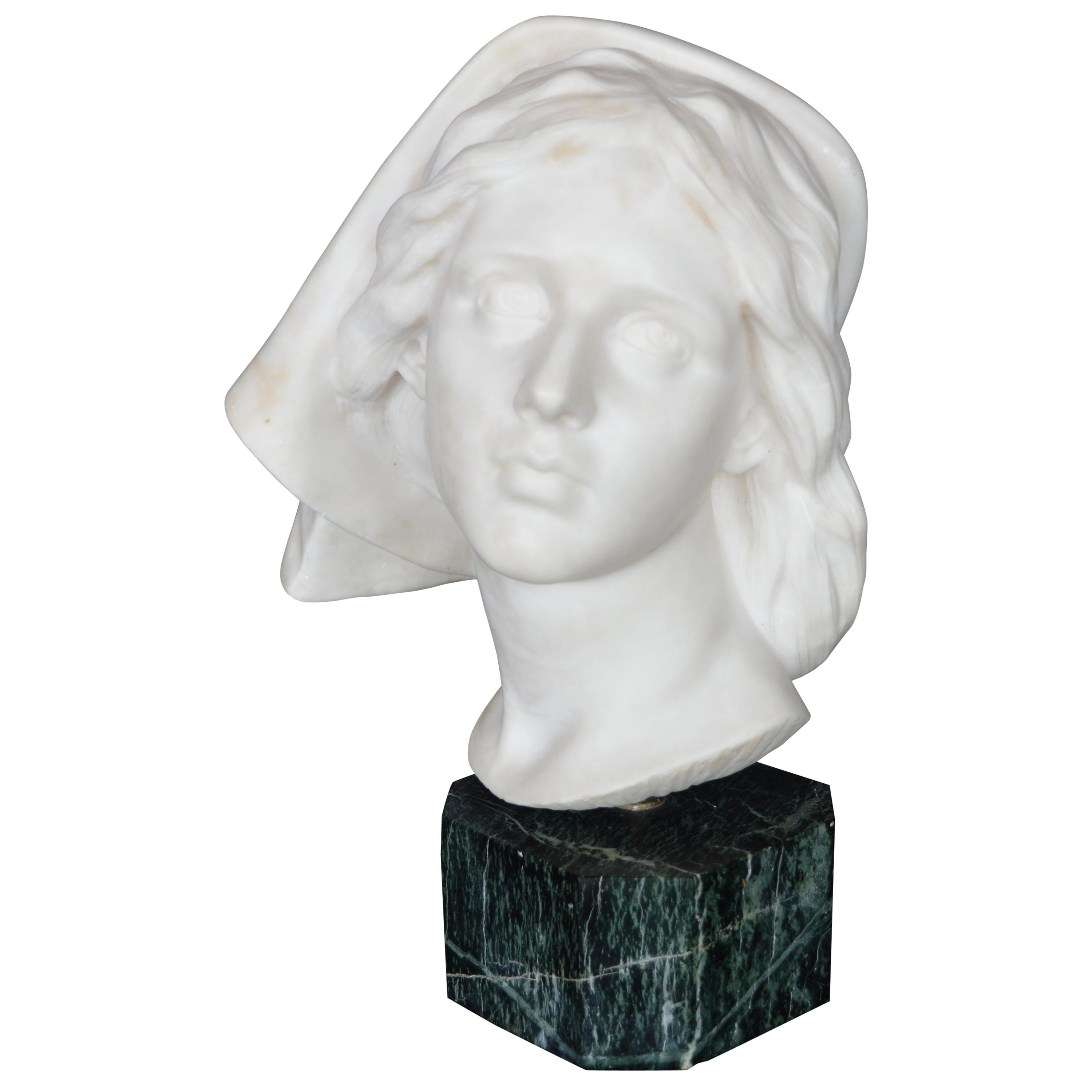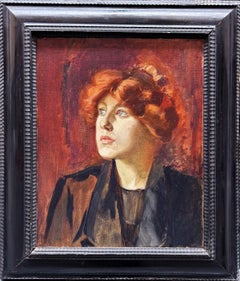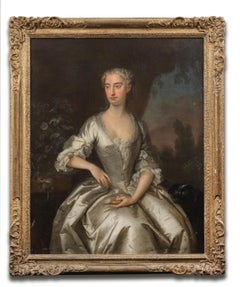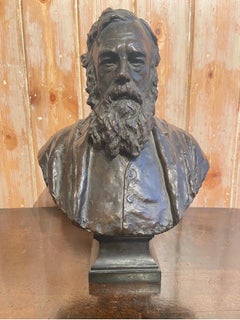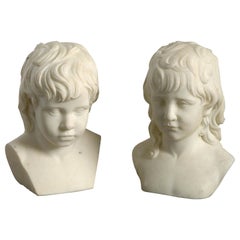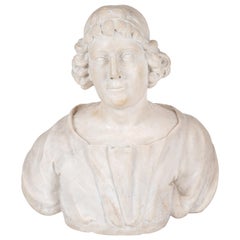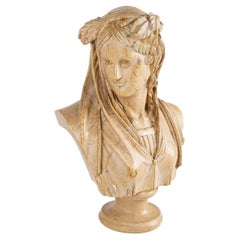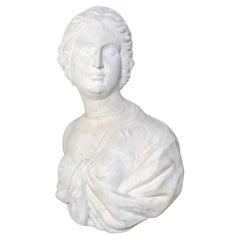Items Similar to Regency-era Life Portraits in Marble
Want more images or videos?
Request additional images or videos from the seller
1 of 4
Regency-era Life Portraits in Marble
$22,978.41
£17,143
€19,922.31
CA$32,194.76
A$35,062.51
CHF 18,487.24
MX$426,461.31
NOK 232,476.26
SEK 218,043.72
DKK 148,765.62
About the Item
Attributed to Bertel Thorvaldsen
Regency-era Life Portraits in Marble
1770-1844
Marble on period ebonised wooden columns
Bust height: 59 cm crown to socle
Bust width: 28 cm
Column height: 106.5 cm
These twin busts are portraits carved from life, and likely depict two young women from a noble family. They date from the Regency era, which is reflected in their fashionable curled hair styles. The busts - whose features are reminiscent of sculptures of antiquity - sit atop two period ebonised wooden columns designed with a neoclassical style. The dark colour of these columns contrasts with the white marble of the busts, ensuring that the ladies’ faces remain the focus of the viewer. The busts are believed to have been carved by Bertel Thorvaldsen, a preeminent neoclassical sculptor renowned across Europe.
Bertel Thorvaldsen
Bertel Thorvaldsen was born in November 1770 in Copenhagen as the son of a wood-carver who made decorative carvings for large ships. Thorvaldsen grew up with little education or knowledge of high culture, but his artistic ability to carve and sculpt was noted from a young age. At the age of 11, and with help from many around him, Thorvaldsen was admitted to the Royal Danish Academy of Art, initially as a draftsman but later at the modeling school. He won a number of prizes during his studies and was granted a Royal stipend to study in Rome, where he arrived in March 1797.
In Rome, Thorvaldsen’s studio was located near the Spanish steps. He was mentored by the Danish archaeologist Georg Zoega, which sparked Thorvaldsen’s love of depicting themes of antiquity in his statues and his appreciation for neoclassical themes and style. Thorvaldsen’s first notable success was his model for a statue of Jason and the Golden Fleece, created in 1801. It attracted the attention of the most popular sculptor in Rome - Antonio Canova - but it took another two years for Thorvaldsen to receive the commission to create the statue in marble. This commission would tie Thorvaldsen to Italy for the next sixteen years.
With the commendation of Canova under his belt, Thorvaldsen quickly became internationally famous. He completed a number of commissions for important clients such as Ludwig I of Barvaria, Lord Byron, and the Vatican. He produced a tomb monument of Pope Pius VII, marking him as the only non-Italian to be commissioned by the Vatican. Thorvaldsen became so popular with the aristocracy of Europe that he was forced to expand his workshop in 1805 and enlist the help of assistants to cut the marble, whilst Thorvaldsen remained in charge of initial sketches and finishing touches.
In 1819, Thorvaldsen visited to Denmark and was commissioned to produce a series of sculptures of Christ and the Apostles for the rebuilding of Vor Frue Kirke, now known as the Copenhagen Cathedral. Thorvaldsen designed them, but returned to Rome as they were produced - these statues were not completed until 1838, when he returned permanently to his home country. The Christ figure from this series is credited as being one of the most widely reproduced religious statue in the world.
Thorvaldsen was received back in Denmark as a national hero, given his international reach and success. He began to fund the construction of the Thorvaldsen Museum near Christiansborg Palace, which would house the works that he had created and collected. The museum would become the first in the world to be dedicated to a single artist, and was also the first public museum in Denmark.
Bertel Thorvaldson died in March 1844. As per his request, his body was reinterred in the courtyard of the Thorvaldsen Museum in 1848 shortly before the institution’s opening. Thorvaldsen left behind a key legacy as a pioneer of neoclassical art with a flair for the antique Greek style, and is often heralded as Canova’s successor. His works can be found in major global collections, such as the Louvre, the Metropolitan Museum New York, the Alte Nationalgalerie, and the Victoria and Albert Museum.
- Attributed to:Bertel Thorvaldsen (1770 - 1844, Danish)
- Dimensions:Height: 23.23 in (59 cm)Width: 11.03 in (28 cm)
- Medium:
- Period:
- Condition:
- Gallery Location:London, GB
- Reference Number:1stDibs: LU52416431332
About the Seller
5.0
Gold Seller
Premium sellers maintaining a 4.3+ rating and 24-hour response times
Established in 2007
1stDibs seller since 2014
85 sales on 1stDibs
Typical response time: 3 hours
- ShippingRetrieving quote...Shipping from: London, United Kingdom
- Return Policy
Authenticity Guarantee
In the unlikely event there’s an issue with an item’s authenticity, contact us within 1 year for a full refund. DetailsMoney-Back Guarantee
If your item is not as described, is damaged in transit, or does not arrive, contact us within 7 days for a full refund. Details24-Hour Cancellation
You have a 24-hour grace period in which to reconsider your purchase, with no questions asked.Vetted Professional Sellers
Our world-class sellers must adhere to strict standards for service and quality, maintaining the integrity of our listings.Price-Match Guarantee
If you find that a seller listed the same item for a lower price elsewhere, we’ll match it.Trusted Global Delivery
Our best-in-class carrier network provides specialized shipping options worldwide, including custom delivery.More From This Seller
View AllPortrait of Lady
Located in London, GB
John Westbrooke Chandler
1763- 1807
Oil on canvas
Image size: 30 x 25 inches (76 x 63.5 cm)
Original gilt swept frame
This portrait is marked by its loose brushwork, which creates a...
Category
Late 18th Century Academic Portrait Paintings
Materials
Canvas, Oil
$19,301
Portrait of a Lady, Early 20th Century Oil
By Arthur Ambrose McEvoy
Located in London, GB
Follower of Ambrose McEvoy (unsigned)
Circa 1910
Portrait of a Lady
Oil on canvas
Image size: 20 x 16 inches (51 x 40.5 cm)
Original ebonised Frame
A stunning portrait of a lady ...
Category
Early 20th Century Portrait Paintings
Materials
Oil, Canvas
Portrait of Ann Austen, nee Grey
By Bartholomew Dandridge
Located in London, GB
Signed 'BDandridge/ pinxit' lower left
Provenance
By descent through the sitter's family to
The Collection of R. W. Vivian-Neal of Poundisford Park, Somerset, from whom acquired by
With Lane Fine Art, UK, where purchased by the present owners in 1996
Literature
'Poundisford Park, Somerset' in Country Life, 22 December 1934, ill.
A.W. and C.M. Vivian-Neal, Poundisford Park, Somerset: A catalogue of pictures and furniture, Taunton 1939, cat. nos. 11 and 13
This is a portrait of Ann Austen, nee Grey, three-quarter-length seated in a landscape with her dog. Painted in a superb white satin dress, she holds horn spectacles and a spectacle case...
Category
Mid-18th Century English School Portrait Paintings
Materials
Oil
Bust of Frederick William Walker, 19th Century Figurative Sculpture
Located in London, GB
Hope-Pinker was born in Peckham, Surrey, the son of a stonemason and builder employing 5 or 6 men c.1871 in Hove, Sussex, who seems to have taught his son much of his stone-carving skills, although he also attended the Royal Academy Schools (c.1871). Hope-Pinker typically carved without a model from drawings. The bulk of his work was portrait sculpture and John Hunter...
Category
19th Century English School Figurative Sculptures
Materials
Bronze
Reclining Figure Carved Marble Early 20th Century France
Located in London, GB
Circle of Henri-Gaudier-Breska
1891-1915
Reclining Figure
Carved marble
Height 5 inches
Born Henri Alphonse Séraphin Marie Gaudier near Orléans in France, Gaudier-Brzeska started using his hyphenated name in 1910 when he met the Polish writer Sophie Brzeska. They moved to London together in January 1911 and adopted their new names and the identity of brother and sister in order to make their cohabitation respectable.
Gaudier-Brzeska started to establish himself as a sculptor in 1912. Initially influenced heavily by Rodin, he later assimilated more influences from the modernist movement of cubism and from examples of non-European art he saw in London’s museums. He met the sculptor Jacob Epstein in June 1912, who further encouraged him to break with classical Greek tradition.
While working from 25 Winthorpe Road in 1913–14, Gaudier-Brzeska became increasingly involved in London’s avant-garde art scene. He exhibited at the London Salon in July 1913, where he met the poet and arts patron Ezra Pound. Pound described Brzeska as ‘like a well-made young wolf or some soft-moving, bright-eyed wild thing’. Gaudier-Brzeska subsequently became associated with the vorticist movement led by Wyndham Lewis, contributing two important articles to Lewis’s magazine Blast and signing his name against the vorticist manifesto.
He was also a founding member of the London Group, which formed when the all-male Camden Arts Group joined with independent artists to challenge the dominance of the Royal Academy of Arts. Other founding members included Walter Sickert, Robert Bevan and Spencer Gore...
Category
Early 20th Century Figurative Sculptures
Materials
Marble
Bronze Portrait of a Lady
By Adrian Paul Allinson
Located in London, GB
Adrian Paul Allinson
Bronze Portrait of a Lady
Patinated bronze, signed and dated '24 lower base
Dimensions: 8 3/4 x 15 1/2 inches (21 x 39.5 cm)
This fantastic bronze depicts a lad...
Category
20th Century Sculptures
Materials
Bronze
You May Also Like
John de Vaere Statuary Marble Busts
Located in London, GB
A fine pair of George III statuary marble busts of a boy and a girl by John de Vaere (1755 – 1830), 1798.
Signed J DE-VAERE Sculpr. 1798.
Considering what a sensitive and accomplished sculptor he was, surprisingly little is known about John de Vaere. Born in France in 1755, he settled in England some time before 1786 when he enrolled as a student at the Royal Academy Schools. In 1787 he left to study in Rome, with the financial assistance of Josiah Wedgwood. In Rome he won a Silver Medal for Sculpture from the Pope and became an assistant to John Flaxman.
On his return to England in 1790, he worked as a modeler for Wedgwood until the latter’s death in 1795, after which he worked with Eleanor Coade, probably replacing John Bacon...
Category
Antique Late 18th Century Busts
Materials
Statuary Marble
18th Century, Carrara Marble Bust
Located in Los Angeles, CA
Hand carved, marble bust in three quarters, of a young man in a sensitively rendered, open-neck robe, with flowing hair held in a delicate circlet.
Category
Late 18th Century Sculptures
Materials
Marble
Roman Style Solid Marble Bust
Located in Franklin Park, IL
Roman style solid marble bust
This bust measures: 15 wide x 10 deep x 23 inches high
This piece is in Great Vintage Condition with minor marks,...
Category
20th Century American Classical Roman Busts
Materials
Marble
Antique Italian Carrara Marble Bust
Located in Dallas, TX
An antique and reclaimed Italian bust, carved in the 19th century from fine Carrara marble. The sculpture depicts a classical female figure, her features softened yet dignified, fram...
Category
Antique 19th Century Busts
Materials
Carrara Marble
Antique Regency Statuary Marble Bust
Located in Wormelow, Herefordshire
An antique Regency white statuary marble bust of a young Roman man.
Dating to 1820, this is an impressive sculpture of a young man, wearing a Roman toga on a round socle base in Reg...
Category
Antique Early 19th Century Italian Grand Tour Busts
Materials
Marble, Statuary Marble
Late 19th Century Italian Marble Bust
Located in Los Angeles, CA
Carrara marble bust of a young girl.
Category
Antique Late 19th Century Italian Busts
Materials
Carrara Marble
More Ways To Browse
Sculptures In Marble
Used Religious Statues
Pope Pius
Antique Religious Statues
Golden Fleece
Wooden Bust
Golden Fleece Used
Thorvaldsen Museum
Jason And Golden Fleece
Thorvaldsen Marble
Kennedy Musekiwa
Murakami Vinyl
Norma Minkowitz
Outdoor Glass Sculpture
Picasso Bull Ceramic
Picasso Ceramic Poisson
Picasso Madoura Bird
Pink Buddha
